Basic Color Matching Instructions
In order to minimize the many variables inherent in color identification, I have standardized both the light source and the color-matching process.
Before starting, take some time to "unstick" the color slides. When the holes are punched into the slides, they tend to "stick" to the paper inserts. Fan out the slides one at a time to break this bond.
The Process for Insulators
First, lay the insulator on its' side on the light table and try to match your color by looking down through the dome glass.
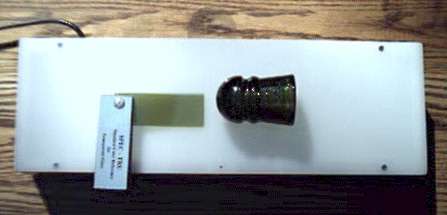
If there isn't much dome glass to use, or if the color is too dark, then look down through the skirt.

If the color is very dark, look through the skirt from inside the insulator.
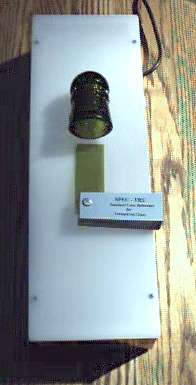
Each of the color slide combinations that result are annotated to identify which "view" was used so that others can duplicate the process.
| The 'default' process is to match by looking through the dome. | |
| A single asterisk (*) after the color combination denotes a match by looking down through the skirt. | |
|
A double asterisk (**) after the color combination denotes a match by looking through the skirt from inside the insulator.
|
Using a Color Index
If you are using a Color Index specification (see Insulator Index or Fruit Jar Index) to match a known color, fan out the slide(s) indicated. Combine multiple slides into one - the order is unimportant.
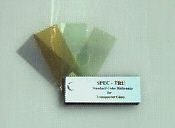
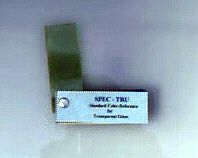
Match the slides to your insulator following the process outlined above. In many cases you will get an exact match, but sometimes your specimen will be just a shade lighter or darker. Try adding slides 1002/1005/1010 or 503/505/605 to darken or lighten the color. That's all there is to it!
Matching without an Index
Without an index, color mixing to match your specimens is a skill indeed - and it may take you a while to match the first few that require multiple slides. Donít be discouraged, however, as it is an aptitude that can be quickly acquired. Follow these step-by-step instructions.
1. Fan out the color slides in the color range closest to the specimen (e.g. the 400's for a light blue or aqua blue). If a perfect match can be obtained from a single slide, separate it from the others and go to Step 4.
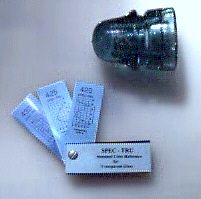 (Here I've chosen three shades of blue; slides 420, 425,
and 430.)
(Here I've chosen three shades of blue; slides 420, 425,
and 430.)
2. If a perfect match cannot be obtained from a single slide on its own, then multiple slides will be required. Select the two adjacent slides nearest the specimen color and fan them out. (Using one slide here is easier, but two increases your options of finding a good match sooner.) Use the color mixing table below to choose a slide for adding to the slides already selected. Pull out the third slide and try it in combination with each of the other two slides (overlay the slides).
Mix with to Make
reds blues purples
greens blues aquas
yellows light blues greens
yellows pinks oranges
light greens oranges orange ambers
medium reds medium greens brown ambers
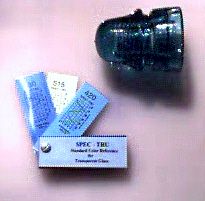 (Too much blue - so I've added some green, slide 515, to mix with slide 420 and then with slide 430.)
(Too much blue - so I've added some green, slide 515, to mix with slide 420 and then with slide 430.)
3. If a match still cannot be obtained, choose another third slide, perhaps a lighter or darker shade than the first attempt. If the color to be matched is a base color, (e.g. blue) try adding different blues together if a single slide does not match the specimen.
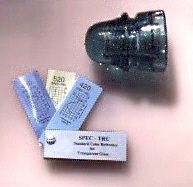 (The color was close, but too light. Here I've chosen a darker green, slide 520, to use with slides 420 and 430.)
(The color was close, but too light. Here I've chosen a darker green, slide 520, to use with slides 420 and 430.)
The neutral grays near the end of the kit can also be added to darken the color slides. Sometimes they are all that is needed to make a match. Milk Glass specimens can be matched by adding the 1100 diffusion slide to your selections.
Finding the right combination of slides requires persistence, but it gets easier as you become more familiar with color combinations.
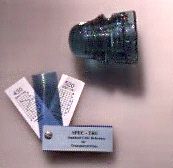 A match!
Slide 520 with slide 430 produces a perfect color match.
A match!
Slide 520 with slide 430 produces a perfect color match.
4. Describe your color with Spec-Tru numbers. Don't forget to identify which "view" was used to make the color match. If you used a single slide to match your color, then simply add that number to the color name, prefixed with "CN".
For example:
CD 162 Hemingray-19, Hemingray Blue, CN480
Perfect Seal Fruit Jar, Green Aqua, CN580
If multiple slides were needed to match your specimen, they can be described this way:
CD 162 California, Blue Aqua, CN430+520
Perfect Seal Fruit Jar, Light Turquoise Green, CN515+580